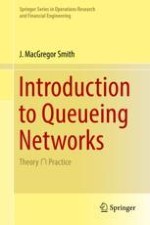2018 | OriginalPaper | Buchkapitel
6. Closed Queueing Network Performance Models \(f{\bigl (G(V,E,N)\bigr )}\)
verfasst von : J. MacGregor Smith
Erschienen in: Introduction to Queueing Networks
Aktivieren Sie unsere intelligente Suche, um passende Fachinhalte oder Patente zu finden.
Wählen Sie Textabschnitte aus um mit Künstlicher Intelligenz passenden Patente zu finden. powered by
Markieren Sie Textabschnitte, um KI-gestützt weitere passende Inhalte zu finden. powered by
Overview
-
Product-Form Networks: Starting from the basic exact algorithms developed by Gordon and Newell, we discuss their use and illustrate with several examples and algorithms along with their performance and optimization wherever possible.
-
Non-product-Form Networks: General service time distributions are treated next and we present algorithms and optimizations. Because of the complexity of this problem, the focus is mostly on approximation algorithms.
-
Blocking Networks: As in open network algorithms, blocking in closed networks is extremely complex, and we present a series of approaches for treating blocking in closed networks.
-
Transportation and Loss Networks: Movement of goods from one queue to another in closed networks is of course very important, and we present an approach based upon state-dependent algorithms.
